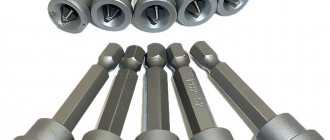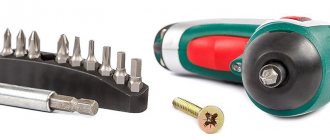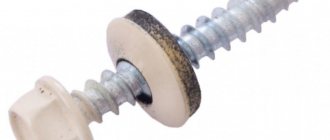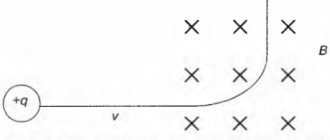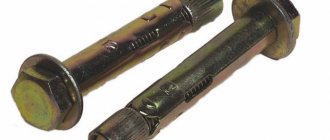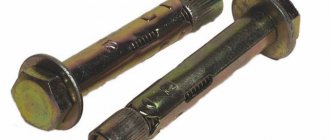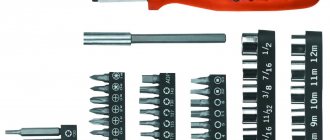Perhaps you need:
Screwdriver attachment PH 2x25mm
More details
Screwdriver attachment PZ 2x50mm
More details
Screwdriver attachment PH 2x50mm
More details
The use of special attachments (bits) in assembly technology was at one time due to the rapid failure of the tips of conventional screwdrivers when used professionally. In this regard, replaceable bits, invented in the first half of the 20th century, turned out to be more profitable and convenient.
When tightening several hundred screws with a screwdriver with a tip, they began to change not the screwdriver, but only its attachment, which was much cheaper. In addition, when working with several types of fasteners at once, many different tools were not required. Instead, the only screwdriver required changing the bit, which only took a few seconds.
However, the main motivation for the use of bits was the invention of centered fastener heads. The most common of them are cruciform ones - PH and PZ. Upon careful study of their designs, it can be established that the tip of the nozzle, pressed into the center of the screw head, does not experience significant lateral forces that throw it beyond the head.
Other types of fastening heads used today are also built according to the self-centering system. They allow you to twist elements not only at low speeds, but also at significant speeds with a large axial load.
The only exceptions are S-type straight blade bits. These were historically intended for the very first hand-tightened screws. There is no centering of the bit in straight splines, so when the rotation speed increases or the axial pressure decreases, the bit slips out of the fastening head.
This can result in damage to the front surface of the element being fastened. Therefore, in the mechanized assembly of critical products, connections with straight spline elements are not used.
Its use is limited to less critical fasteners with low tightening speeds. When assembling products with mechanical tools, only those types of fasteners are used that ensure a reliable fit of the nozzle to the fastening element.
Bit classification
Fastening bits can be classified according to several criteria:
- type of fastening system;
- head size;
- bit shaft length;
- rod material;
- metal coating;
- design (single, double);
- possibility of bending (regular and torsion).
The most important thing is to divide the bits into types of fastening systems. There are many of them, the most common ones will be discussed in a few paragraphs.
Almost every type of system has several standard sizes, differing in the size of the tool head and the corresponding fastening slot. They are designated by numbers. The smallest ones start from 0 or 1. The recommendations for the type indicate the diameters of the threads of the fasteners for which the bit is intended under a specific number. Thus, the PH2 bit can be used with fasteners with a threaded diameter from 3.1 to 5.0 mm, PH1 is used for self-tapping screws with a diameter of 2.1–3.0, etc.
For ease of use, bits are available with different shaft lengths - from 25 mm to 150 mm. The tip of a long bit reaches the slots in places where a larger bit holder cannot reach.
Fasteners for slotted screwdriver, bit - SL (Slotted).
Screws
1. Screws with low cylindrical head and straight slot DIN 84, GOST 1491-80, EN ISO 1207.
0.3x2.0
| 0.4x2.5 | 0.5x3 | 0.6x3.5 | 0.8x4 | 1x5.5 | 1.2x6.5 | 1.2x8 | 1.6x10 | 2x12 | 2.5x14 | |
2. Straight slot screws with cylindrical rounded head DIN 85, GOST 17473-80, EN ISO 1580.
0.3x2
| 0.4x2.5 | 0.5x3 | 0.6x3.5 | 0.8x4 | 1x5.5 | 1.2x8 | 1.6x10 | 2x12 | 2.5x14 | ||
4. Set screws for a slotted screwdriver with a cylindrical end (trunnion) and a flat end: DIN 417, EN ISO 7435, DIN 427, EN ISO 2342.
Self-tapping screws for metal
1. Self-tapping screws for metal with a semicircular (cylindrical) head and a straight slot DIN 7971, EN ISO 1481.
Materials and coating
The alloy material from which the bat is made is the key to its durability or, conversely, the softness of the design, in which, if the specified forces are exceeded, it is not the fastening element that breaks, but the bat. In some critical connections this strength ratio is required.
However, in the vast majority of applications, the user is interested in the maximum possible number of tightenings of the fastener with one bit. To obtain strong bits that do not break due to the fragility of the alloy, and do not deform at the most loaded touch points, various alloys and steels are used. These include:
- high-speed carbon steels from R7 to R12;
- tool steel S2;
- chrome vanadium alloys;
- tungsten-molybdenum alloy;
- chromium-molybdenum alloy and others.
Special coatings play an important role in ensuring the strength properties of bits. Thus, a layer of chrome vanadium alloy protects the tool from corrosion, and sputtering a layer of titanium nitride significantly increases its hardness and wear resistance. Diamond coating (tungsten-diamond-carbon), tungsten-nickel and others have similar properties.
The titanium nitride layer on the bit is easily recognizable by its golden color, and the diamond layer by the characteristic shine of the tip. The brand of metal or alloy of a bat is more difficult to find out; the manufacturer usually does not provide or even hides this information for commercial interests. Only in some cases can a steel grade (S2, for example) be applied to one of the faces.
Stainless steel self-tapping screws
Wood grouse screw DIN571 plumbing (A2,A4)
The stainless steel capercaillie screw DIN 571 is made of A2 or A4 steel. Designed for fastening wooden logs, beams, slats and other wooden substructures. It is possible to use a combination of screw + plastic or metal dowel. Quite often used in conjunction with a reinforced washer.
Roofing screw DIN 7504K (standard drill) (A2,A4)
The stainless steel self-tapping screw DIN 7504K is designed for fastening various metal structures without pre-drilling holes. The hex head is equipped with a pressed washer. Made from A2 or A4 steel.
Self-tapping screw with countersunk head DIN 7504O (A2)
Self-tapping screw made of stainless steel A2 DIN 7504O, countersunk head, Philips slot. Designed for working on metal, aluminum, stainless steel without pre-drilling. The tip is drill-shaped.
Self-tapping screw with semicircular head DIN 7504M (A2,A4)
Self-tapping screw DIN 7504M made of A2 or A4 stainless steel is intended for fastening structures in conditions of increased environmental aggressiveness. Designed for fastening sheet materials made of various metals (stainless steel, galvanized, aluminum, tin, etc.). Equipped with a drill and does not require additional drilling during installation.
Screw DIN 7976, hex head (A2)
The stainless steel screw DIN 7976 (A2 steel) is ideal for use in highly aggressive environments (moisture, reagents, dirt, etc.). Used for fastening sheet materials such as plywood, plastic, metal sheets, etc. The head has a hexagon shape and is designed for a wrench or a special attachment.
Screw DIN 7981, semicircular head, PH slot (A2,A4)
The stainless steel screw DIN 7981 is made of A2 or A4 steel. Resistant to aggressive environments. Used for fastening plywood, plastic sheets, stainless steel sheets and other sheet materials. The semicircular head ensures maximum sheet pressing. Philips slot.
Screw DIN 7981, round head, Z slot (A2)
The screw DIN 7981 is made of stainless galvanized steel. Equipped with a semicircular head with a Z slot - cross-shaped, with a sharp tip. Used for securing wood, sheet materials, and metal.
Screw DIN 7982, countersunk head, PH slot (A2,A4)
The DIN 7982 screw made of A2 or A4 stainless steel is designed for fastening various parts in aggressive environmental conditions. Suitable for both wood and metal structures, however, to screw into metal parts, a hole must be pre-drilled. Countersunk head, Philips slot.
Screw DIN 7982, countersunk head, PZ slot (A2)
Screws DIN 7982 have a countersunk head, PZ (cross-shaped) slot. Material of manufacture: stainless steel. When screwing into wood or plastic, no pre-drilling of the hole is required.
Screw DIN 7983, half-counting head, PH slot (A2,A4)
Stainless steel screw (A2/A4) DIN 7983 is used for operation in conditions of increased aggressiveness of the environment (water vapor, salts, alkalis, acids, etc.). Allows you to fasten wooden, plastic and metal (with preliminary drilling) structures. Semi-countersunk head with Philips slot.
Self-tapping screw “Bedbug” cross-head slot (A2)
The “Bedbug” self-tapping screw is used in construction to obtain high-quality fastenings; it is equipped with a drill, which makes it possible to fasten metal without preliminary drilling. The head has a press washer with a cross slot. Material of manufacture: stainless steel A2.
Self-tapping screw with internal hexagon (A2)
The self-tapping screw DIN 912 has a cylindrical head with a hexagonal recess. Material: stainless steel, coating: galvanized. Scope of application: mechanical engineering, construction, repair, installation.
Design options
By design, the bit can be single (a tip on one side, a hex shank on the other) or double (two tips at the ends). The latter type has a double service life (both tips are the same) or ease of use (the tips differ in size or type). The only disadvantage of this type of bit is the impossibility of installing it in a hand screwdriver.
Bits can be produced in regular and torsion versions. In the latter design, the tip itself and the shank are connected by a durable spring insert. It works by twisting, transmits torque and allows you to bend the bit, which increases the ability to access inconvenient places. The spring also absorbs part of the impact energy, protecting the bit from breaking the splines.
Torsion bits are used with impact screwdrivers, in which the impact force is applied tangentially to the screwing circle. Bits of this type are more expensive than regular ones, last longer, and allow you to screw long fasteners into dense materials that regular bits cannot handle.
For ease of use, bits are produced in different lengths. Each following standard size (25 mm) is 20-30 mm longer than the previous one - and so on up to 150 mm.
The most important characteristic of a bit is its service life. It is usually expressed in the number of fasteners screwed in before the tool fails. Deformations of the tip are manifested in the gradual “licking” of the ribs as the bit slips out of the slot. In this regard, the most resistant bits are those that are not subject to forces that throw them out of the slot.
The most commonly used systems include H, Torx and their modifications. In terms of strong contact between the bit and the fastener, there are many other systems, including anti-vandal ones, but their distribution is limited for a number of technical reasons.
Drywall screwdriver bits
PZ (Pozidriv) bits are made with strictly parallel edges. This shape guarantees retention in the screw head under any tightening forces. Visually, these types can be distinguished by the presence of additional protrusions between the edges or small recesses on the head of the screws at an angle of 45 degrees with respect to the main splines. The slight non-parallelism of the PH (Philips) slots is designed so that, with a certain force when tightening, the edges are pushed out of the screw head.
This shape promotes self-centering of the tool in the slots of the head, even when the tool is at a certain angle. Drywall screwdriver bits are produced exclusively by PH. As stated above, the bit size is 2. Thus, the inscription on the tool should be PH2. As a rule, those devices that come with a screwdriver are of rather low quality and serve only to familiarize yourself with the capabilities of the tool. All quality add-ons must be purchased separately.
For working with a screwdriver, various devices are produced, which differ not only in geometric dimensions, but also in the shape of the splines. The most common are bits with edges of the RN and PZ types. The untrained eye will not see much difference in them, except for the additional protrusions on the tool marked PZ.
The difference lies in the geometry of the splines. The bit for a drywall screwdriver has slot planes at a slight angle to each other. For PZ they are strictly parallel.
Main types of bits used
The number of types of bits, including those that have fallen out of use due to low technical suitability, amounts to several dozen. Today, the following types of screwdriver attachments are most widely used in fastening technology:
- PH (Phillips) - cross-shaped;
- PZ (Pozidriv) - cruciform;
- Hex (denoted by the letter H) - hexagonal;
- Torx (denoted by the letters T or TX) - in the form of a six-pointed star.
PH nozzles
The PH Phillips, introduced after 1937, was the first self-centering tool for driving screw-threaded fasteners. The qualitative difference from the flat tip was that the PH cross did not slip out of the slot even when the tool was rotated quickly. True, this required some axial force (pressing the bit against the fastener), but ease of use compared to flat splines increased sharply.
Clamping was also required in screws with a flat slot, but when tightening with a PH bit, it was not necessary to apply attention and effort to limit the possibility of the tip slipping out of the slot. The tightening speed (productivity) has increased dramatically even when working with a manual screwdriver. The use of a ratchet mechanism, and then pneumatic and electric screwdrivers, generally reduced the complexity of assembly operations several times, which provided significant cost savings in any type of production.
The PH bit has four blades that taper in thickness towards the end of the bit. They capture the mating parts of the fastener and tighten it. The system is named after the engineer who introduced it into fastening technology (Phillips).
PH bits are available in five sizes - PH 0, 1, 2, 3 and 4. Rod length - from 25 (main) to 150 mm.
PZ nozzles
About 30 years later (in 1966), the PZ (Pozidriv) fastening system was invented. It was developed by Philips Screw Company. The shape of the PZ tip is cross-shaped, like that of the PH, but both types have such serious differences that they do not allow the bit of one system to properly tighten the fasteners of the other. The sharpening angle of the end of the bit is different - the PZ has it sharper (50 º versus 55 º). The PZ blades do not taper like those of the PH, but remain equal in thickness throughout their entire length. It is this design feature that has reduced the force of pushing the tip out of the slot under high loads (high twisting speeds or significant rotational resistance). Changing the design of the bit improved its contact with the fastener head, which increased the service life of the tool.
The PZ bit differs from the PH bit in appearance - grooves on both sides of each blade, forming pointed elements that are absent on the PH bit. In turn, to distinguish it from PH, manufacturers apply characteristic notches on PZ fasteners, shifted 45º away from the power ones. This allows the user to quickly navigate when choosing a tool.
PZ bits are available in three standard sizes PZ 1, 2 and 3. The length of the rod is from 25 to 150 mm.
The greatest popularity of the PH and PZ systems is explained by the good capabilities of automatic tool centering in in-line assembly operations and the relative low cost of tools and fasteners. In other systems, these benefits have weaker economic incentives, so they are not widely adopted.
Hex attachments
The shape of the tip, designated in the marking by the letter H, is a hexagonal prism. The system was invented back in 1910 and enjoys continued success today. Thus, confirmed screws used in the furniture industry are tightened with H 4 mm bits. This tool is capable of transmitting significant torque. Thanks to the tight connection with the fastener slot, it has a long service life. There is no force to push the bit out of the slot. H nozzles are available in sizes from 1.5 mm to 10 mm.
Torx bits
Torx bits have been used in technology since 1967. They were first mastered by the American company Textron. The sting is a prism with a base in the form of a six-rayed star. The system is characterized by tight contact between the tool and the fastener and the ability to transmit high torque. Widely distributed in America and Europe, in terms of popularity the volume of use is close to the PH and PZ systems. A modernization of the Torx system is an “asterisk” of the same shape, complemented by a hole in the axial center. The fastener for it has a corresponding cylindrical protrusion. In addition to even tighter contact between the bit and the screw head, this design also has an anti-vandal property, preventing unauthorized unscrewing of the connection.
Other types of attachments
In addition to the popular attachment systems described, there are also lesser-known and less commonly used types of screwdriver bits. The following bits fall into their classification:
- for a straight slot type S (slotted - splined), invented in the 26th century;
- Hex type with a hole in the center;
- Robertson type square prism;
- fork type SP (“fork”, “snake eye”);
- three-bladed Tri-Wing type;
- four-bladed type Torg Set;
- and others.
Companies are developing their unique bit-fastening systems both to prevent non-experts from accessing instrument compartments and to protect against vandals looting the contents.
Choosing a drill for a self-tapping screw
If we are talking about standard drills, and not bits for screwdrivers, then choosing the right attachment for a drill is much easier. In this case, you must first decide on the type of screws themselves. They can be for a wooden or metal base. In the first case, the fastening elements are distinguished by a very small distance between the turns on the leg. Thanks to this, the fixation is reliable. Typically, the diameter of the fastener is 3.5 cm, which does not require pre-drilling a hole.
Thin sheet metal usually requires more preparation work and a pre-hole. Its size depends on how thick the metal is used. Knowing this parameter, you can select the optimal drill:
- If the metal thickness is 0.7 mm, you should use a 3.3 mm drill.
- A drill with a diameter of 3.4 mm (common type) is optimal for sheets with a thickness of 1.0 mm.
- For 1.5 mm metal, a 3.5 mm drill (the most popular bit) is suitable.
- If the sheet thickness is 2.0 mm, then a larger 3.6 mm drill can be used.
- For 3.0 mm metal, a 3.6 mm nozzle is suitable.
- When using thick sheets, it is recommended to use a more powerful 3.8 mm drill.
Recommendations for choosing bits
A good bat can perform many more fastener tightening operations than its simplified counterpart. To choose the desired tool, you need to contact a retailer whose employees you trust and get the necessary recommendations. If this is not possible, choose bits from well-known manufacturers - Bosch, Makita, DeWALT, Milwaukee.
Pay attention to the presence of a hardening titanium nitride coating, and also, if possible, to the material of the product. The best way to choose is to try out one or two pieces of equipment in your own business. This way you will not only determine the quality of the product yourself, but will also be able to give recommendations to your friends. Perhaps you will settle on an inexpensive option that has clear economic or technical advantages over the originals of famous companies.
High-quality screwdriver attachments can always be purchased at the Stroybat online store for professional fasteners.
Bit with limiter for drywall: advantages of use
A bit with a limiter for installing gypsum plasterboards is a special type of attachment that prevents the self-tapping screw from damaging the gypsum board when tightened with a drill or screwdriver. The limiter resembles a cup, the dimensions of which are larger than the head of the bit. When twisted, the protective element rests against the sheet and does not allow the cap to penetrate the body of the gypsum board. Thanks to this limiter, the master does not have to worry about overtightening the self-tapping screw.
You should be aware that limit bits are manufactured for different types of materials, and this is indicated by the markings on the product. If work is carried out with gypsum plasterboard, then the nozzle must be chosen specifically for this type of building material, otherwise the likelihood that the sheet will be damaged increases significantly. Work using an nozzle with a restrictive element is significantly faster, since there is no need to waste time on constant checking quality of fasteners. The only thing that is needed is minimal experience and skills in working with the tool, because it is impossible to screw in self-tapping screws with your own hands: for this you need to use a drill or screwdriver. In any of these cases, the consequence of pinching is a loss of strength, and therefore the durability of the structure.
And only a bit with a limiter for drywall will help prevent such problems. When installing plasterboard sheets (GKL), you can easily damage the product by accidentally squeezing the screw. As a result, cracks form in the body of the gypsum, weakening it, or damage to the top layer of cardboard occurs.
Sometimes the head of the self-tapping screw goes right through the gypsum board, as a result of which the sheet is not fixed to the metal profile in any way.
Tri-Wing Splined Bits - Three Blade
When marking these attachments, the letters TW are used. A distinctive feature of these bits is the presence of 3 blades on the tip. They are used in the assembly of household appliances and electronics. They are also used in the aerospace industry. These bits first appeared in 1958 and were invented by Philips Screw Company. The size is designated by the letters Gr and can have indicators from Gr.1 to Gr.6.
Which bits don’t float for Shuriks?
Well, “instantly”.
Yeah.. About a hundred self-tapping screws (black, 75 for wood). For comparison, Bosch (USA) lives for years under such operating conditions. The bits are still alive
Strange. I have one Witte bit that survived an apartment in the old building (there are joists + plywood in 2 layers) for about 160 meters and died only because they turned on the impact mode in the screwdriver, it simply split. I don’t remember what episode it was.
M/1914 wrote: yeah... About a hundred self-tapping screws (black, 75 for wood).
Some kind of bullshit. Maybe a leftist? Titanium coated ones last quite a long time.
Maybe, of course, he’s a leftist, but the bat itself is beautiful, the inscriptions are written well... And so is the packaging. I remember that the end that was inserted into the holder was “twisted” with a rosette (the scratch apparently came from the cutter). When I get to the store I’ll take a photo.. + I have one at home right now, that PH1 - the edges are thoroughly licked off..
M/1914 wrote: I have one at home right now, that PH1 - the edges are thoroughly licked off..
If it's not a secret, what did you play on her?
M/1914 wrote: For comparison, Bosch (USA) lives for years under such operating conditions.
Bosch USA is practically a legend. They are not available in stores.
The Chinese made a mistake when they wrote. This often happens to Asians. For them, the Latin alphabet is like the Chinese alphabet for us.
Alex___dr wrote: If it's not a secret, what did you play to her?
Are you implying that maybe you used bits to turn the fasteners that were not their size? Those. for example, with a bat RN1 we turned the screws RN2.
I answer point by point:
- If the bit is PH1, then I use it to tighten the screws under PH1, very rarely PZ (when there is no PZ bit)
- Bosch-USA may be a legend among you, but I bought a lot of them in my time - I still have a couple of packs lying around, and we still have them in stores. If you don't like the Bosch comparison, let it be Wurth. Wurth's resource is no less than Boshevsky's. This evening I will try to post a photo of that same witte PH1.
ADM05 wrote: The Chinese made a mistake when they wrote. This often happens to Asians. For them, the Latin alphabet is like the Chinese alphabet for us.
I took a closer look - “Made in Germany LA”. In this case, the last two letters are in a smaller font, but capitalized. And printed at an angle. Complete scam
ADM05 wrote: Are Witte bits sold in your city?
I know only one place where they are sold in Novosibirsk
sledoput wrote: I took a closer look - “Made in Germany LA”.
on 50mm bits there is a postscript EB (if my eyes didn’t deceive me, I couldn’t find a magnifying glass). The postscript is made as if below the main line, maybe this is some kind of classification
ADM05 wrote: Bosch-USA is practically a legend. They are not available in stores.
There is one on eBay, and you can always immediately look for Magna, it is also available.
Has anyone seen Hammer bits for sale? Am I the only one who thinks they look very good?
lomaster Well, external similarity is not a guarantee of bit resistance.
Looks like another NoName, with coloring and logo it looks like a green Bosch
lomaster wrote: Has anyone seen Hammer bits for sale? Am I the only one who thinks they look very similar to good ones?
I would risk taking unfamiliar bits with this name only after a very authoritative recommendation
M/1914 wrote: yeah... About a hundred self-tapping screws (black, 75 for wood). For comparison, Bosch (USA) lives for years under such operating conditions. The bits are still alive
Black self-tapping screws for Ph? And did you use them for wood? They are knee-mounted, under drywall. Then the bits must be used corresponding to the torsion zone. Maybe they will still live under such extreme conditions. In general, for wood, self-tapping screws with Pz, Torx, hexagons, with appropriate hardening.
lomaster wrote: Has anyone seen Hammer bits for sale? Am I the only one who thinks they look very similar to good ones?
. IMHO for this money it is better to take the proven quality Bison Expert or Whirlpower (Scrub). Our Zubr Expert costs on average 60 rubles for 2 50 mm bits, i.e. for 8 (as in your set) it turns out to be 240 rubles, but they are 50 mm!. Whirlpower costs an average of 20 rubles per bat if you buy in packs of 10 pieces. And if you need something of better quality, then here it is: . The bits are most likely still made in Germany, the adapter in the Czech Republic. IMHO, here the quality already corresponds to the price. The Wera Rapidator is an indispensable tool when you need to work with one hand.
lomaster wrote: Has anyone seen Hammer bits for sale? Am I the only one who thinks they look very similar to good ones?
Is the yellow paint a type of sumeregano-hard coating designed for millions of twists?
